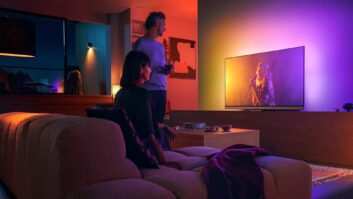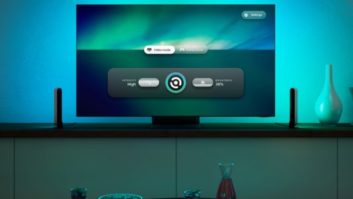New York — Philips will introduce later this year its first DLP-based rear-projection HDTV sets under the volume-oriented Magnavox brand — and possibly in the step-up Philips line — but will emphasize its role as a leader in flat-panel HDTV sales and development, Des Power, Philips’ sales and marketing senior VP announced at the company’s summer line review.
Philips chose to underplay the DLP rear-projection television announcements during the recent pre-Christmas summer showcase — revealing the decision only during the Q&A portion of the presentation — as it stressed new flat-panel plasma and LCD HDTVs using its proprietary “AmbiLight 2” backlighting system.
The company will introduce a Magnavox-branded DLP HDTV set in third quarter, with details to be announced later, the company said. In explaining Philips’ decision to underplay DLP, Power said Philips sees flat-panel television eventually dominating the television market.
“As a consumer electronics company, we are passionately and aggressively driving our flat-TV business,” Power said. “It is our belief that the aggressiveness and excitement in the flat-TV business is going to continue to put the squeeze on the entire microdisplay segment, and it is Philips’ belief that that is going to put microdisplay on the quartile-two part of the business.
“Seeing as we have the perfect brand to do that, we are looking at having a Magnavox DLP product to compete in that more budget-oriented part of the segment, and we will be going full steam ahead with Philips in our commitment to driving full flat-TV leadership.”
Philips will position DLP under Magnavox, which is traditionally used to market more “mature technologies” and commodity-oriented products.
Last year, Philips had introduced microdisplay rear-projection televisions based on a one-chip LCoS light engine under the Philips brand, but later scrapped the technology as market prices for competitive products using DLP and LCD continued to plummet, hurting Philips’ ability to make a profit from its LCoS offerings.
For this year, Power said Philips has “totally renewed” its flat-panel TV line in large screen sizes 32W-inches and above. All are fully integrated with ATSC digital tuners, and a majority of the models include CableCARD slots, Power added.
The company will offer five plasma models under the Philips brand, including three models in the 50W-inch screen size and two models in 42W-inch sizes. In large-screen LCD TV, Philips will carry two 32W-inch models, one 37W-inch model and two 42W-inch models. All of those models will also include ATSC tuners and CableCARD slots.
At the top of the lines are the company’s AmbiLight models, which feature rear-panel backlighting that illuminates a rear wall with color and brightness levels synchronized to match the predominate look of the image on the screen.
This year, the line will feature two steps of AmbiLight TVs. A 42W-inch plasma, a 42W-inch LCD TV and a 50W-inch plasma TV will each incorporate AmbiLight 1 technology, which debuted last year.
AmbiLight 1 models include the 42W-inch HD LCD TV set, model 42PF9730A ($3,499); the 42W-inch HD plasma set, model 42PF9630A ($2,999); set and the 50W-inch HD plasma set, model 50PF9630A ($4,799).
A step-up 50W-inch (50PF9830A, $5,299 suggested retail) plasma HD set and a 42W-inch LCD HDTV set (42PF9830A, $3,999) will both ship in September featuring AmbiLight 2. The new technology further refines the backlighting system by adding separate systems for each half of the screen. This gives a stereo effect to the synchronized backlighting technology.
Both AmbiLight 2 models will also include Ethernet ports allowing users to connect to wired or wireless adapters to stream JPEG images and other content from remotely located PC hard drives and other devices.
In addition, Philips will feature an entry 42W-inch HD plasma set in the 42PF7320A ($2,699) and a 50W-inch HD plasma set in the 50PF7320A ($4,499). Both include a pair of HDMI/HDCP inputs, ATSC, NTSC and QAM cable tuners and CableCARD slots.
Philips will also feature an entry 32W-inch HD LCD TV in the 32PF7320A ($1,999), also including ATSC/NTSC/QAM tuning and CableCARD slot.
Philips will also carry a line of smaller-screen LCD monitors in the 15-inch; 17W-inch; 19-inch ($579, July); 20W-inch ($699, now); and 23W-inch ($1,599, now) screen sizes.
Scott Levitan, Philips’ flat TV/home entertainment networks VP, said AmbiLight helped Philips expand its retail positioning with flat TVs last year.
“We are very well placed with both leading national accounts, as well as in select regional accounts with AmbiLight,” said Levitan. “There is no major national account where we do not have a presence with our large-screen Philips branded flat TV.”
Levitan said Philips has used its Magnavox brand for select flat-panel TV models to compete aggressively with the numerous third-tier startup companies that are using low-price strategies to gain a foothold in the market.
With our business models, we are able to compete with all brands,” Levitan said.
Power said Philips will continue to support dealers with a full line of CRT direct-view sets and CRT-based rear-projection HDTV sets. He cited market research studies that showed Philips as the No. 2 direct-view CRT-TV supplier in 2004.
“It’s no secret what’s going to happen to the CRT business,” Power said. “We think you have to be extremely clever in how you manage that in the coming couple of years. As a company, I think we have been smart with our investments not only in our [LG.Philips] LCD joint venture, but in our [LG.Philips] CRT tube joint venture.”
Power acknowledged that the CRT business is becoming more commodity oriented, which plays in well with Philips’ dual brand strategy that allows it to position more of the low-end CRT products under Magnavox, while saving some more advanced widescreen HDTV products for the Philips brand.
But going forward, the company’s investment dollars in both research and development and advertising will be focused on “making Philips the flat-TV brand in North America,” Power said.
In video products, Philips showed a pair of new portable DVD players in the PET1000 ($399), featuring silver cosmetics and a 10.2-inch screen and the MCL888 ($399) slot-loading flat-screen, pedestal-base DVD/CD portable player with an 8-inch LCD screen and side-mounted flat-technology speakers for desktop or carry-around the house use.
Philips also showed a combination DVD recorder/DVR featuring an 80GB hard drive, TV Guide On Screen EPG, DivX playback and DVD-RW/-R and DVD+RW/+R compatibility. It will ship in October at a $299 suggested retail.
The company also should an entry DVD recorder in DVDR3355 ($249), featuring DiVX 5 and DVD+RW/+R and DVD-RW/-R disc compatibility.
Also shown was Philips’ first under cabinet LCD/DVD player system designed for kitchens. The $299 unit features a 7-inch swivel LCD screen, DVD/CD support and AM/FM radio.
In a new category, Philips unveiled a pair of electronic picture frames that will store up to 80 high-resolution digital image files for display at 720 by 540 pixel resolution on desktops. The frames, which are available in two design options, carry a $249 suggested retail, and will accept flash memory cards to transfer images into the internal memory or can be connected to a PC to download images via a USB port.
The summer line review also gave Philips an opportunity to introduce Paul Zeven, CEO of Philips Electronics North America. Since entering the new post from Philips Latin America last fall, Zeven has overseen five Philips product divisions encompassing consumer electronics, appliances/personal care, lighting, semiconductors and health care products.
Philips is now integrating its many products and divisions into a unified global brand campaign, supported by a number of television ads that will be placed in countries around the world.
In addition, he said Philips is working to integrate some of its sales and marketing practices to make the company more of a one-stop-shopping resource for various multi-national accounts.
“Rather than having five representatives — five salesmen — go to the same institutions of our customers, we are establishing an international retail board, particularly for consumer products, which is approaching these customers under one flag without any detriment to the specific needs of each product division,” Zeven said.
He pointed out that a number of retailers have become global multinational corporations, creating “a greater need to work with them on a company basis, establishing stronger partnerships,” Zeven said.
“It is not only about selling products,” he continued. “It is about having a similar agenda, catering to consumer needs.”
A similar international business-to-business sales board will be established for hospitals and hotel chains, for example.













